Albufera Natural Park (Valencian: Parc Natural de l'Albufera de València, Spanish: Parque natural de la Albufera, or simply Albufera), is a large natural park in the Valencian Community, Spain.
The natural park encompasses the lake of Albufera (from Arabic: البحيرة al-buhayra – 'small sea'), the villages of Pinedo, El Saler, El Palmar, and Perellonet, and the surrounding wetlands and agricultural area. It draws visitors from Valencia for its beaches, bird watching, and food.
Albufera is Spain's largest lake, and was originally a saltwater bay gradually separated from the sea by a large spit, which finally closed off the lagoon in the Roman period.
Fishing has always been the primary human activity in the area. The reclamation of land for growing rice began in the 17th century, which drastically reduced the surface area of the lake from approximately 30,000 to 2,800 hectares. Over time the water also became more diluted, and today is mostly freshwater. In the mid-twentieth century the lake was further threatened by rampant development. Since the establishment of the natural park in 1990 the region is now protected from further development, and there has been progress in reestablishing vital wetland areas.
The Albufera provides summer breeding habitat for many birds, wintering grounds for others, and for still others is a critical layover spot during migration; in total more than 340 avian species have been identified here. Birds make good use of not only the lagoon itself but also the rice paddies surrounding it.
There are no entrance fees or permits. Access to restricted areas for bird watching can be arranged only through a guide.
- El Palmar. With a name derived from the many palmettos on the island, this village was originally a Moorish farmstead. After the forced deportation of Muslim residents in the mid-13th century, the island was essentially abandoned until the late 18th century when fisherman and their families began to take up permanent residency here. Most modern visitors come here primarily to eat paella (see listings below in 'Eat'), but it is worth taking some extra time to explore the surrounding canals and to see the barracas, traditional thatch-roofed dwellings.
- Barraca dels Arandes, Carrer de Francisco Monleón. The oldest building in El Palmar dates from the 19th century, and is the only one which still has the original construction of adobe walls, packed clay floor, wooden ceiling, and thatched roof. It is not open to the public, but visitors can appreciate it from the outside.
- Muntanyeta dels Sants. Literally 'Mountain of the Saints', this low hill of 27 m altitude is a good spot to view the surrounding landscape of rice paddies and orange groves. Free.
- Ermita dels Sants de la Pedra, Plaça Numero 48. The 14th-century chapel was modified in the 17th century, and is a good example of Gothic architecture from the Reconquista period. It is dedicated to Saints Abdón and Senén, patron saints of the nearby city of Sueca, and on 29 July it is a pilgrimage destination from Sueca during the festival of Benissants de la Pedra. Free.
- Batería republicana de El Saler. A Republican battery and artillery site from the Spanish Civil War.
El Palmar. With a name derived from the many palmettos on the island, this village was originally a Moorish farmstead. After the forced deportation of Muslim residents in the mid-13th century, the island was essentially abandoned until the late 18th century when fisherman and their families began to take up permanent residency here. Most modern visitors come here primarily to eat paella (see listings below in 'Eat'), but it is worth taking some extra time to explore the surrounding canals and to see the barracas, traditional thatch-roofed dwellings.
- Barraca dels Arandes, Carrer de Francisco Monleón. The oldest building in El Palmar dates from the 19th century, and is the only one which still has the original construction of adobe walls, packed clay floor, wooden ceiling, and thatched roof. It is not open to the public, but visitors can appreciate it from the outside.
El Palmar. With a name derived from the many palmettos on the island, this village was originally a Moorish farmstead. After the forced deportation of Muslim residents in the mid-13th century, the island was essentially abandoned until the late 18th century when fisherman and their families began to take up permanent residency here. Most modern visitors come here primarily to eat paella (see listings below in 'Eat'), but it is worth taking some extra time to explore the surrounding canals and to see the barracas, traditional thatch-roofed dwellings.
- Barraca dels Arandes, Carrer de Francisco Monleón. The oldest building in El Palmar dates from the 19th century, and is the only one which still has the original construction of adobe walls, packed clay floor, wooden ceiling, and thatched roof. It is not open to the public, but visitors can appreciate it from the outside.
Muntanyeta dels Sants. Literally 'Mountain of the Saints', this low hill of 27 m altitude is a good spot to view the surrounding landscape of rice paddies and orange groves. Free.
- Ermita dels Sants de la Pedra, Plaça Numero 48. The 14th-century chapel was modified in the 17th century, and is a good example of Gothic architecture from the Reconquista period. It is dedicated to Saints Abdón and Senén, patron saints of the nearby city of Sueca, and on 29 July it is a pilgrimage destination from Sueca during the festival of Benissants de la Pedra. Free.
Muntanyeta dels Sants. Literally 'Mountain of the Saints', this low hill of 27 m altitude is a good spot to view the surrounding landscape of rice paddies and orange groves. Free.
- Ermita dels Sants de la Pedra, Plaça Numero 48. The 14th-century chapel was modified in the 17th century, and is a good example of Gothic architecture from the Reconquista period. It is dedicated to Saints Abdón and Senén, patron saints of the nearby city of Sueca, and on 29 July it is a pilgrimage destination from Sueca during the festival of Benissants de la Pedra. Free.
Batería republicana de El Saler. A Republican battery and artillery site from the Spanish Civil War.
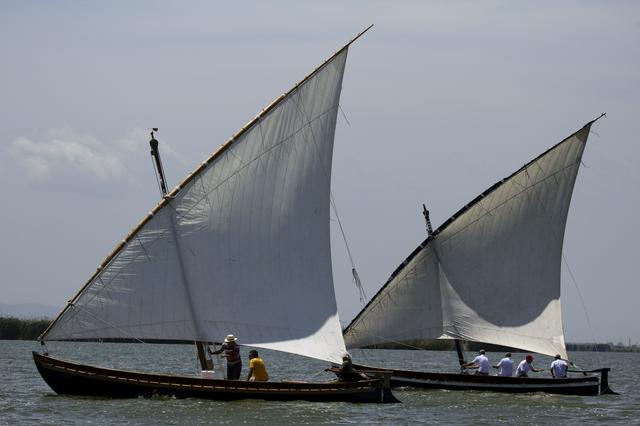
- Embarcador de la Gola de Pujol, Ctra El Palmar, s/n.
- Embarcadero de El Palmar.
Embarcador de la Gola de Pujol, Ctra El Palmar, s/n.
Embarcadero de El Palmar.
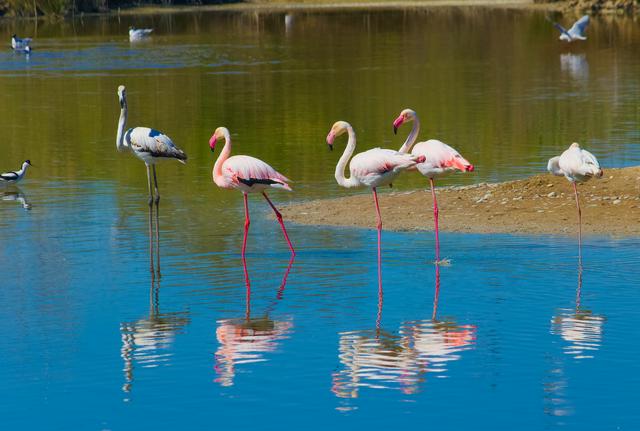 There are several English-speaking guide companies which can enable access to restricted areas, but there are also plenty of opportunities for casual birdwatchers, not only in the lagoon but in the rice paddies.
There are several English-speaking guide companies which can enable access to restricted areas, but there are also plenty of opportunities for casual birdwatchers, not only in the lagoon but in the rice paddies.
- Centre d'Interpretació Racó de l'Olla, +34 963 868 050. Daily 09:00-14:00, closed 1 and 6 Jan and 24, 25, and 31 Dec. The visitor centre can offer information on bird life in the area, and has an observation tower, two bird observatories, and a nature trail through a smaller lagoon. Ample parking is available nearby, and the nearest EMT bus stop. is located a short distance to the north.
- Mirador de la Gola del Pujol, Ctra El Palmar, s/n (by the bus stop. This is a good viewing spot for waterbirds especially between the months of October and March, when fixed fishing posts with nets are placed in the water. This spot is particularly popular in the afternoons and on weekends, and there is limited parking available. Free.
Centre d'Interpretació Racó de l'Olla, +34 963 868 050. Daily 09:00-14:00, closed 1 and 6 Jan and 24, 25, and 31 Dec. The visitor centre can offer information on bird life in the area, and has an observation tower, two bird observatories, and a nature trail through a smaller lagoon. Ample parking is available nearby, and the nearest EMT bus stop. is located a short distance to the north.
Mirador de la Gola del Pujol, Ctra El Palmar, s/n (by the bus stop. This is a good viewing spot for waterbirds especially between the months of October and March, when fixed fishing posts with nets are placed in the water. This spot is particularly popular in the afternoons and on weekends, and there is limited parking available. Free.
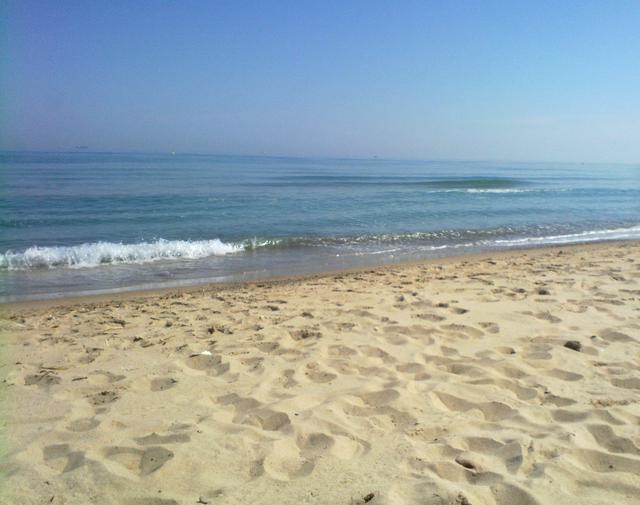 South of Pinedo. is a long stretch of land with a dense pinewood, dunes and marshes that separates the lake from the sea. These beaches are on "protected" land and are the cleanest, most secluded beaches within easy reach of Valencia. Despite being very near the city, due to their protection and lack of the services of an urban or resort beach, they are generally pretty quiet, something not few people might prefer to the more urban beaches. The summer season generally runs from the beginning of June until the beginning of September, and during this period all beaches have lifeguards, first aid stations, and toilets (unlocked daily 10:00-19:30).
South of Pinedo. is a long stretch of land with a dense pinewood, dunes and marshes that separates the lake from the sea. These beaches are on "protected" land and are the cleanest, most secluded beaches within easy reach of Valencia. Despite being very near the city, due to their protection and lack of the services of an urban or resort beach, they are generally pretty quiet, something not few people might prefer to the more urban beaches. The summer season generally runs from the beginning of June until the beginning of September, and during this period all beaches have lifeguards, first aid stations, and toilets (unlocked daily 10:00-19:30).
- Platja de Pinedo. Summer season: 7 Jun - 7 Sep. The closest beach to Valencia and the most urban, with a number of cafés and snack vendors. Has disabled access and showers, sun loungers are available for rent, and dogs are permitted on the northernmost section of beach.
- Platja de l'Arbre del Gos. A stretch of beach with a more natural setting, and a nudist section. Facilities drinking fountains, showers, and picnic benches.
- Platja d'El Saler. The nicest and best-developed beach. Facilities include disabled access and showers, drinking fountains, and picnic tables, and sun loungers are available to rent.
- Platja de la Garrofera. Has a nudist section. Facilities include disabled access, a walkway, and showers.
- Platja de la Devesa. Undeveloped, with natural surroundings, this beach can be reached on foot walking for about 5-10 minutes from the parking area. Has a nudist section.
- Platja del Recatí. Summer season: 1 Jul - 31 Aug. An urban beach with fine sand. Has disabled access and showers.
South of Pinedo. is a long stretch of land with a dense pinewood, dunes and marshes that separates the lake from the sea. These beaches are on "protected" land and are the cleanest, most secluded beaches within easy reach of Valencia. Despite being very near the city, due to their protection and lack of the services of an urban or resort beach, they are generally pretty quiet, something not few people might prefer to the more urban beaches. The summer season generally runs from the beginning of June until the beginning of September, and during this period all beaches have lifeguards, first aid stations, and toilets (unlocked daily 10:00-19:30).
Platja de Pinedo. Summer season: 7 Jun - 7 Sep. The closest beach to Valencia and the most urban, with a number of cafés and snack vendors. Has disabled access and showers, sun loungers are available for rent, and dogs are permitted on the northernmost section of beach.
Platja de l'Arbre del Gos. A stretch of beach with a more natural setting, and a nudist section. Facilities drinking fountains, showers, and picnic benches.
Platja d'El Saler. The nicest and best-developed beach. Facilities include disabled access and showers, drinking fountains, and picnic tables, and sun loungers are available to rent.
Platja de la Garrofera. Has a nudist section. Facilities include disabled access, a walkway, and showers.
Platja de la Devesa. Undeveloped, with natural surroundings, this beach can be reached on foot walking for about 5-10 minutes from the parking area. Has a nudist section.
Platja del Recatí. Summer season: 1 Jul - 31 Aug. An urban beach with fine sand. Has disabled access and showers.
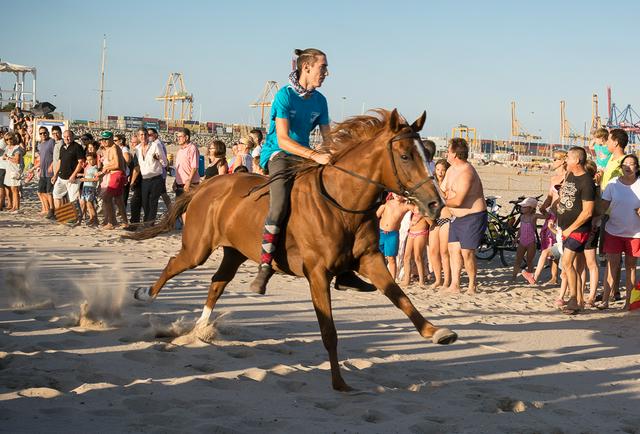
- Romería del Cristo, El Palmar. 4 August; procession begins at 18:00. This religious festival celebrates the pilgrimage of Cristo de la Salud (Christ of Health). The procession begins at the Plaça de la Sequiota. in front of the parish church, and proceeds to the boat launch. Here, with much music and fanfare, the Christ effigy is placed into a boat and taken out onto the lake, followed by other boats packed with villagers from El Palmar and neighbouring villages of Catarroja and Silla. After being taken around the lake the effigy is returned to the church and there is a mascletà, or gunpowder celebration.
Spectators wishing to book a spot on a boat to follow along should make arrangements at least six weeks in advance, although with a bit of luck it may be possible to find a spot on the same day by asking around; going rates are per passenger. - Corregudes de Joies, Platja de Pinedo (Pinedo, +34 963 248 964. 3 days in early to mid-August; races begin at 19:00. This annual event is a series of 500m-long bareback horse races on the beach. Formally organized since 1823, the races date back to the 18th century and were once held in most of the agricultural districts immediately south of Valencia; today they are still held only in the village of Pinedo. They came about as a competition between orchard farmers betting on the strength and speed of their farm horses. Literally meaning 'race of jewels' in Valencian, the 'jewel' is a silk scarf tied to the racer's arm and formerly given to the beloved of the winner. Nowadays the final winner receives all scarves tied to a laurel wreath. Free.
Romería del Cristo, El Palmar. 4 August; procession begins at 18:00. This religious festival celebrates the pilgrimage of Cristo de la Salud (Christ of Health). The procession begins at the Plaça de la Sequiota. in front of the parish church, and proceeds to the boat launch. Here, with much music and fanfare, the Christ effigy is placed into a boat and taken out onto the lake, followed by other boats packed with villagers from El Palmar and neighbouring villages of Catarroja and Silla. After being taken around the lake the effigy is returned to the church and there is a mascletà, or gunpowder celebration.
Spectators wishing to book a spot on a boat to follow along should make arrangements at least six weeks in advance, although with a bit of luck it may be possible to find a spot on the same day by asking around; going rates are per passenger.
Corregudes de Joies, Platja de Pinedo (Pinedo, +34 963 248 964. 3 days in early to mid-August; races begin at 19:00. This annual event is a series of 500m-long bareback horse races on the beach. Formally organized since 1823, the races date back to the 18th century and were once held in most of the agricultural districts immediately south of Valencia; today they are still held only in the village of Pinedo. They came about as a competition between orchard farmers betting on the strength and speed of their farm horses. Literally meaning 'race of jewels' in Valencian, the 'jewel' is a silk scarf tied to the racer's arm and formerly given to the beloved of the winner. Nowadays the final winner receives all scarves tied to a laurel wreath. Free.
- Mercadillo, Plaça de la Sequiota (El Palmar. Tu mornings. A weekly street market, good for picking up fresh local produce and other food items.
Mercadillo, Plaça de la Sequiota (El Palmar. Tu mornings. A weekly street market, good for picking up fresh local produce and other food items.
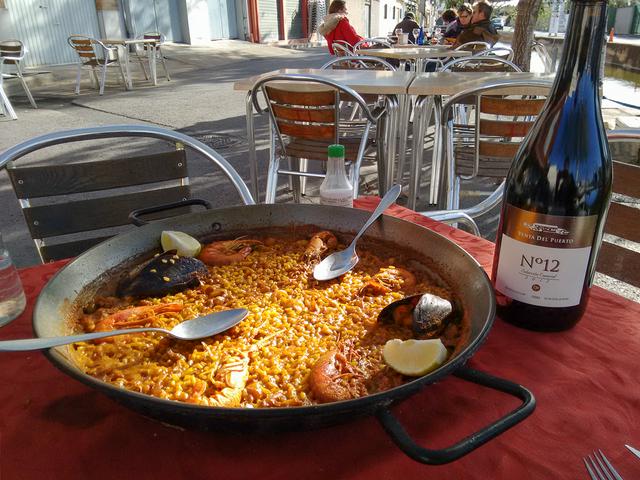
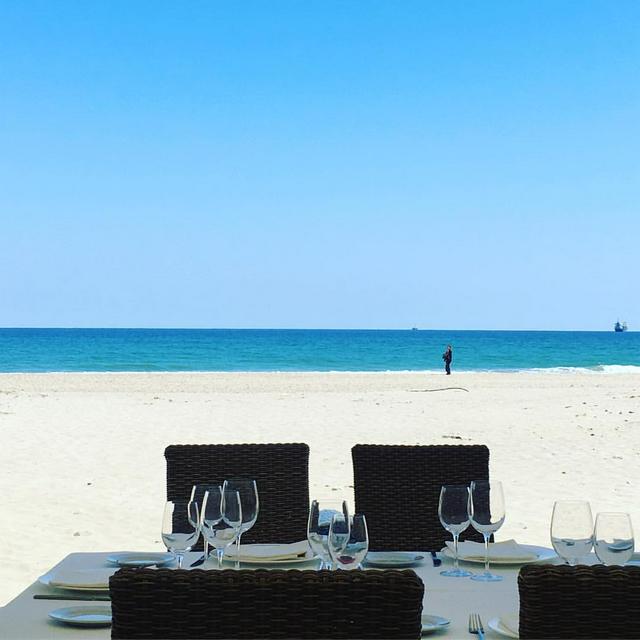 Albufera is known as the birthplace of Valencia's most famous rice dish, paella, which is believed to have developed from its Arabic roots into its current modern form around the mid-19th century. The most traditional version is paella valenciana, which includes white and green beans, chicken, rabbit, snails, and occasionally artichokes. Other versions include paella marisco, which replaces the meat with seafood and eliminates the green vegetables, and paella vegetariana, or vegetarian paella. Other local dishes include all i pebre, a stew with peppers, garlic, potatoes and eels, and espardenyà, a casserole-style dish incorporating the ingredients of paella valenciana but without the rice.
Albufera is known as the birthplace of Valencia's most famous rice dish, paella, which is believed to have developed from its Arabic roots into its current modern form around the mid-19th century. The most traditional version is paella valenciana, which includes white and green beans, chicken, rabbit, snails, and occasionally artichokes. Other versions include paella marisco, which replaces the meat with seafood and eliminates the green vegetables, and paella vegetariana, or vegetarian paella. Other local dishes include all i pebre, a stew with peppers, garlic, potatoes and eels, and espardenyà, a casserole-style dish incorporating the ingredients of paella valenciana but without the rice.
Most restaurants are clustered in the villages of El Saler and in El Palmar, which has highest concentration, almost all of them specializing in rice dishes and equally reliable. As eating paella in El Palmar is a very popular weekend excursion for Valencians, it's a good idea to choose a place to eat before the 14:00 midday rush when tables quickly disappear.
- Alquería de Brosquil, Casa El Llarc, 1 (Castellar, +34 963 757 970. Daily 13:00-18:00 (kitchen 13:00-16:00), Sa 20:00-24:00 (kitchen 20:00-23:00). Located in an orange grove on the northern edge of the Albufera, the former farmhouse is now a favourite spot with locals, with a focus on locally-sourced, traditional rice dishes and seafood. Reservations are essential, especially on weekends. Mains.
- Alquería de la Mar, Camí dels Muntanyars, 161 (Pinedo, +34 963 247 172. Tu-Su 13:30-18:30.
- Arrocería Duna, Paseo Pintor Francisco Lozano, Módulo 3, s/n (El Saler, +34 961 830 490. Daily 12:00-16:00 20:00-24:00. On the beach. Reservations are recommended, and can be made online. Mains.
- Arrocería L'Estibador, Paseo de la Dehesa, 3 (El Saler, +34 961 830 540. Tu-Su 13:00-16:00. Also on the beach. Reservations recommended. Mains.
- Llar del Pescador, Plaça de la Sequiota, 11 (El Palmar, +34 692 640 720. Daily 08:00-23:00.
- Restaurante L'Establiment, Camino Estell, s/n (El Palmar, +34 961 620 100. W-M 13:30-16:30. In a former farmhouse set by a canal and surrounded by rice paddies, this restaurant is rather more expensive but very highly-regarded by locals. Reservations recommended, especially on weekends.
- Restaurante L'Illa, Plaça de la Sequiota, 22 (El Palmar, +34 961 620 242. Tu-Su 10:00-17:00 20:00-23:00. Set menu.
- Restaurante El Palmar, Carrer dels Redolins, 4 (El Palmar, +34 961 620 162. Daily 09:00-23:00.
- Restaurante Planta Azul, Carrer de Francisco Monleón, 29 (El Palmar, +34 961 620 148.
- Restaurante Racó de les Eres, Carrer dels Redolins, 98 (El Palmar, +34 650 362 480. Th-Tu 9:00-23:30.
Alquería de Brosquil, Casa El Llarc, 1 (Castellar, +34 963 757 970. Daily 13:00-18:00 (kitchen 13:00-16:00), Sa 20:00-24:00 (kitchen 20:00-23:00). Located in an orange grove on the northern edge of the Albufera, the former farmhouse is now a favourite spot with locals, with a focus on locally-sourced, traditional rice dishes and seafood. Reservations are essential, especially on weekends. Mains.
Alquería de la Mar, Camí dels Muntanyars, 161 (Pinedo, +34 963 247 172. Tu-Su 13:30-18:30.
Arrocería Duna, Paseo Pintor Francisco Lozano, Módulo 3, s/n (El Saler, +34 961 830 490. Daily 12:00-16:00 20:00-24:00. On the beach. Reservations are recommended, and can be made online. Mains.
Arrocería L'Estibador, Paseo de la Dehesa, 3 (El Saler, +34 961 830 540. Tu-Su 13:00-16:00. Also on the beach. Reservations recommended. Mains.
Llar del Pescador, Plaça de la Sequiota, 11 (El Palmar, +34 692 640 720. Daily 08:00-23:00.
Restaurante L'Establiment, Camino Estell, s/n (El Palmar, +34 961 620 100. W-M 13:30-16:30. In a former farmhouse set by a canal and surrounded by rice paddies, this restaurant is rather more expensive but very highly-regarded by locals. Reservations recommended, especially on weekends.
Restaurante L'Illa, Plaça de la Sequiota, 22 (El Palmar, +34 961 620 242. Tu-Su 10:00-17:00 20:00-23:00. Set menu.
Restaurante El Palmar, Carrer dels Redolins, 4 (El Palmar, +34 961 620 162. Daily 09:00-23:00.
Restaurante Planta Azul, Carrer de Francisco Monleón, 29 (El Palmar, +34 961 620 148.
Restaurante Racó de les Eres, Carrer dels Redolins, 98 (El Palmar, +34 650 362 480. Th-Tu 9:00-23:30.
- Discoteca Spook Pinedo, Carrera del Riu, 399 (Pinedo, +34 632 018 663. Sa 00:00-08:00. A long-established part of the Valencia nightclub scene, with four bars and a dance floor.
Discoteca Spook Pinedo, Carrera del Riu, 399 (Pinedo, +34 632 018 663. Sa 00:00-08:00. A long-established part of the Valencia nightclub scene, with four bars and a dance floor.
